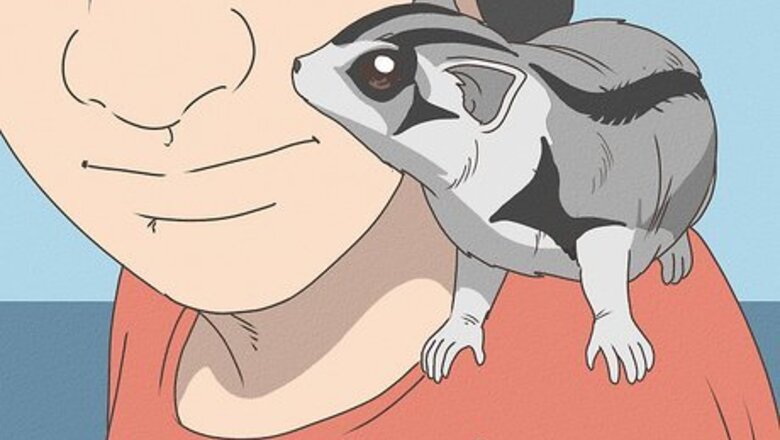
views
Be warned, however, that in many parts of the world, including Australia, New Zealand and in some American states and Canadian provinces it is illegal to own or care for a sugar glider without a permit as they are seen as exotic animals. [1]
X
Research source
Knowing Sugar Glider Basics
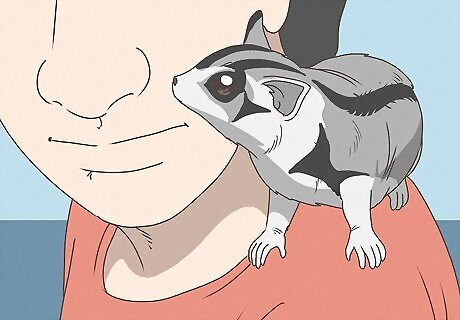
Take the time to bond with your glider. One of the most special things about sugar gliders is their need for socialization. Gliders are capable of a lot of love and if you spend time with them and give them respect, they will grow to trust you. Gliders form strong bonds and can become despondent when the bond is broken. Before bringing home a glider and starting the bonding process, make sure you want to keep the glider for its entire lifespan, which could be up to 15 years. Though some breeders will sell single gliders, gliders do much better in pairs or colonies. It's much better to get two gliders if you want them to stay happy and healthy. Starting the bonding process is as simple as wearing some fleece squares on your person for a few days, then putting them inside their sleeping pouch. They are very scent oriented and this will help them recognize you as part of their colony. Carrying them in a bonding pouch during the day is a great way to bond. They'll mainly sleep and you can coax them into the pouch with treats. Carry them close to your chest and don't let it bounce around too much. This also helps them get used to your scent. Give them treats, but not too many. Offer them when you wake them up to put them in a bonding pouch or when you want to play with them. This will help them understand they shouldn't fear you. One useful technique for play time is "tent time." Playing with your gliders in a tent allows them freedom to roam without worrying about making a mad dash to catch them before they end up somewhere you can't coax them out of. Another great idea if you don't have a tent is "tub time" where you can sit in a clean bathtub with them. Make sure a towel is covering the hole underneath the door, a plug is in the bathtub, and the toilet seat is down.
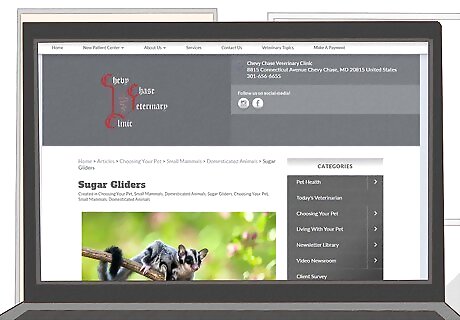
Find a veterinarian for exotic animals. Just like dogs and cats, sugar gliders occasionally get sick. Before you bring a pair of sugar gliders home, make sure you have a vet in your area who specializes in glider care. You should bring your gliders in for a checkup about once a year to make sure they're doing well. Neutering your male glider is highly recommended unless it has lineage to prevent possible inbreeding if paired with a female. If you have males together, it's still better to have them neutered to help prevent fighting. Try to find at least two emergency vets in the area and have their numbers in case something happens. Sugar Gliders often seem to get sick after regular business hours.
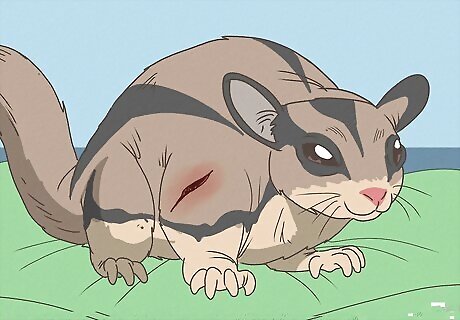
Look out for common illnesses that affect sugar gliders. When conditions are right, sugar gliders are relatively low maintenance pets. However, from time to time they may become ill due to lack of essential nutrients, not getting enough playtime, and other causes. If you see signs that your sugar gliders aren't feeling well, take them to the vet right away. Here are the common illnesses that affect them: Calcium deficiency, which can cause paralysis and is preventable as long as you feed your gliders the correct diet. Some good diets are TPG, BML, and OHPW Constipation or indigestion Open wounds from getting scratched or caught on a sharp part of the cage Obesity due to eating too many fatty foods Stress caused by poor socialization or being alone UTI, which is easy to spot. The most common sign is hissing while using the bathroom.

Connect with other glider owners in your area. It is great fun to connect with other glider owners to share the joy. Plus they can be a great resource when you have to ask questions. There are many forums and message-boards that are glider-related.

Be careful when you take your gliders outside. Sugar gliders, even when fully bonded, may run off to explore nearby and any nearby animals will be a risk to them. It's not recommend to have them outside unless you absolutely know they'll stay with you. Be watchful of other pets and loud noises that might scare them up a tree or into the drain pipe. They are very fast escapees. Do not use harnesses or leashes with Sugar Gliders. They can severely damage their patagium, neck, or spine.

Play with them as often as you can, but don't worry too much about it. They are social animals, but as long as you have at least two, it's fine to just play with them once a week or so. Don't stop using all the bonding techniques and keep playing with them even after they're fully bonded. Even once bonded they'll still want you to keep them company sometimes.
Setting Up a Cage and Keeping it Clean

Buy or build a sizable cage. One amazing qualities sugar gliders have is their ability to spread their legs and glide through the air. In order to do this, in captivity, they need a nice tall cage. Though many breeders will give you a cage with your purchase, it may not be big enough. The minimum cage size for a pair of gliders is 3 feet (0.9 m) high by 2 feet (0.6 m) wide with no more than ⁄2 inch (1.3 cm) bar spacing. If you have extra room, the bigger (and taller) the better. There are several sources for cages online, or you can check your local pet store. Many glider owners build custom cages that fit the needs of their household. Avoid galvanized steel cages because they can rust and cause urinary tract infections in gliders. No need to worry about the direction of the bars. They have opposable thumbs and can climb easily on horizontal or vertical bars. Check that the wood if safe for gliders, of building or buying a wooden cage. Remember that wood is harder to clean and absorbs odors though.

Place the cage on a large tray lined with bedding. This is useful for absorbing waste and stray food, and you can easily change out the bedding when it gets soiled. A plastic or metal tray works just fine. Use paper bedding such as CareFresh or other nontoxic bedding available such as yesterday's news cat litter or puppy pads. Change it out once a week or so. Only use kiln dried bedding. The oils in other wooden bedding can cause health problems for sugar gliders. If you don't want to buy bedding, you can use newspaper or another nontoxic material from around the house.
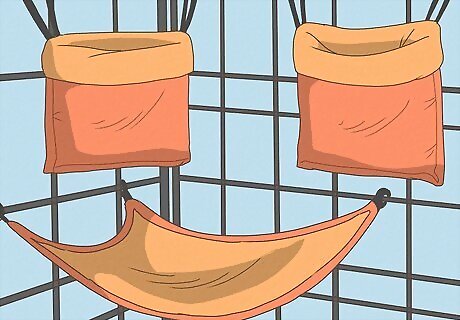
Provide a pouch. Sugar gliders are nocturnal, and in their natural environment they sleep in trees. To replicate that experience in captivity, place a wooden birdhouse (made of safe wood such as manzanita or eucalyptus), or a fleece pouch with a slit in the side, Attach it to the side of the cage by using plastic c-links to affix it to the mesh or bars. Be sure any pouches are sewn safely for gliders, with small, hidden seams to keep their nails from catching on it. Many vendors online sell glider safe pouches and cage sets. It's important to make sure the nesting box is made from nontoxic materials. A fleece or 100% cotton (outside only) bag is a good choice, or an untreated manzanita, applewood, or eucalyptus bird house is good. It's always good to enhance their lives and buy both. Hollowed-out coconuts are another popular choice. Provide more than one to add some variety.

Add safe branches and toys to the cage. Sugar gliders are intelligent and need an engaging environment. You need to stimulate your gliders' minds with interesting things to look at touch, smell and climb. Use eucalyptus branches. Attach them to the sides of the cage to replicate their natural environment, as well as cut down on smell and give them something to chew on. Toys can be bought from vendors online, or made from plastic baby toys and chains. Always make sure they are safe though, with no places they could get stuck or pinched.

Always be sure to have a glider safe wheel, as the ones at pet stores are almost never safe for them. There are a many brands that are safe, of these Raptor wheels and Stealth wheels are most popular. Consider rotating toys and rearranging the elements in the cage on a regular basis. Check online for ideas on how to make the best possible habitat for your gliders. Glider forums are filled with great ideas for toys and other interesting things to add to the cage. If your gliders are understimulated, they will become depressed. This can lead to long-term health problems.

Avoid cleaning too often. As sugar gliders are scent oriented, if nothing smells like them they will mark everything even more and make it smell worse. Clean the cage itself one week, the pouches the next, and the toys the next. This will help prevent them from over making. You can use unscented baby wipes daily to wipe down particularly dirty sections. Use a vinegar and water mixture with a few drops of eucalyptus essential oil to clean the cage and toys. The pouches and any other fabric can be washed by hand or in the washer with a little unscented detergent and/or a cup of vinegar. Check for any loose pieces or seams in the cage, pouches, and toys when cleaning and repair or replace accordingly.
Feeding Your Sugar Glider

Provide a healthy diet. Sugar gliders are native to Australia, Indonesia, and a few other places, where they live on a diet of sap, bird eggs, lizards, insects, and other wild foods. Preparing food for sugar gliders is more like feeding animals in a zoo than opening a bag of kibble. There are several diet plans available, such as TPG, BML, or OHPW, which all provide a Step by step guide for feeding gliders. All these diets are accompanied by fruits and vegetables nightly. Be sure to follow them exactly as if you don't you may throw off the ratios. Both help the gliders get the calcium they need to avoid malnutrition and HLP (hind leg paralysis). Do some research online to find one that works for you, add some of them are more strict than others. Never feed gliders pellets as a total diet, while they are okay as a snack or emergency food, they are not a good diet. They have too little protein as well as fillers. It may seem as though food prep for sugar gliders will take a lot of time, but once you get the hang of it you can prepare enough food for the whole month in one day. The important thing is to make sure you provide the right ration of protein, sugars, and fats, and ensure your gliders are getting the minerals they need to stay healthy. Do not feed sugar gliders dog food, cat food or other foods not meant for sugar gliders. They don't contain the nutritional makeup that sugar gliders need to thrive. Do not feed garlic, rhubarb, onions, or anything in those families. Do not feed fresh lima beans. If bought frozen, they're fine, but otherwise they need to be cooked.
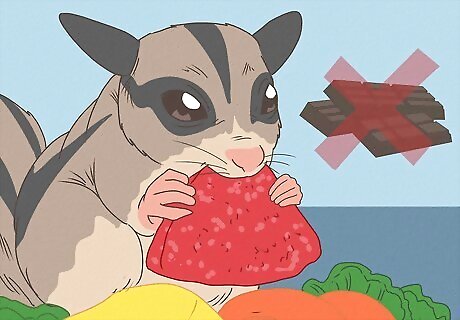
Keep snacks on hand. Gliders love snacks, and can be a great resource for bonding. One of the favorites is live meal worms, though they are high in fat so feed in moderation. Seeing how much your little guy loves mealies will help you get over the "ick" factor (most pet stores sell plastic tweezers). Other snacks include fresh fruit, dried unsulfured papaya, dried unsulfured coconut, yogurt drops, pine nuts (in limited quantities), peas, and "lickey treats" which could be yogurt, applesauce or baby food. (Hawaiian Delight and chicken with apples are favorites.) When choosing snacks avoid all artificial sweeteners, colors or other non-natural ingredients. Never feed sugar gliders plain sugar, candy, or chocolate, as these will cause health problems. Only white chocolate is safe, any other chocolate is toxic to them.

Provide fresh water at all times in the cage, and feed them at night. Using a weighted food dish is best or they may tip it over. Keep the water bottle or silo full at all times, but only feed them the specified amount of food each night. You should feed them at night around the time they wake up, and then take out the dish and any leftover food in the morning. You can leave a tablespoon of glider cereal, sold by The Pet Glider, in their cage during the day in case they wake up and are hungry.
Learning the Truth about Common Misconceptions
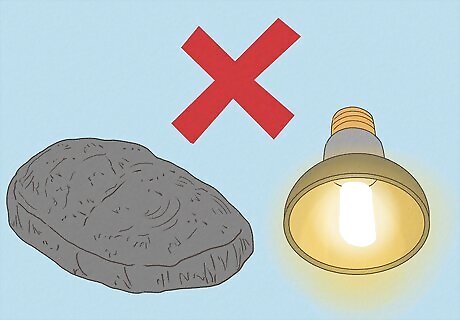
Sugar Gliders do not need heat lamps or heat rocks. They are able to regulate their body temperature like we can. During the winter, consider using a space heater in the room with them and providing a cage cover or small fleece squares in their sleeping pouch as blankets.

Know that they need a specialized diet. They are exotic animals with specific nutritional needs, and not having a balanced diet can cause illness and eventually death. Pellets should not be a part of their diet. While it is fine for a snack or emergency food, this should not be a main part of any glider's diet.

Sugar Gliders can and will breed with their relatives. This can cause birth defects or disorders in joeys, and can cause the parents to cannibalize them. If your gliders do not have lineage proving they are not related, you shouldn't breed them. If you have two males together they should be neutered as this helps prevent fighting.
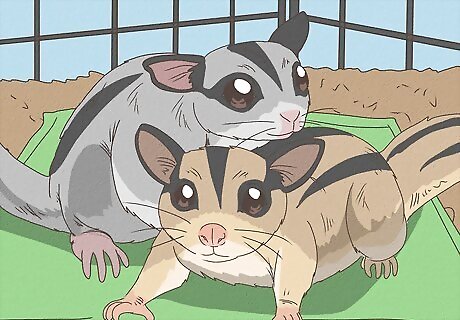
Know that they need companions. They are very social colony animals, and without other gliders they get depressed and will self-mutilate. It is not healthy to have only one. They can over groom and pull out small tufts of fur, they may stop eating or running in their wheel and sometimes they may even start chewing on their tails which can lead to the tail having to be amputated. Even if you spend a lot of time with a lone glider, you can not speak their own language, you can not cuddle together with them in their sleeping pouch during the day, you can not groom each other like gliders do. They need cage mates.

Refrain from buying from Malls, Fairs, or Flea Markets. These places are very similar to a puppy mill. They often sell underage and sometimes even sick sugar gliders. They charge too much compared to what you’d pay a breeder or for a rescue. They also usually sell unsafe and even dangerous supplies like leashes, wire or wodent wheels, tiny cages, etc. These people usually push a pelleted diet, as well. Consider adopting or rescuing. Many people purchase gliders as "impulse buys" because they are very cute, then come to regret the decision when they realize how much work is required in caring for them. You can usually find at least a few locally on Craigslist or Sale groups on Facebook. They will normally be much cheaper than buying joeys from a breeder. Also consider buying from a reputable breeder. They will charge less than a Mall, Fair, or Flea Market vendor, but usually more than a rescue or adopting.














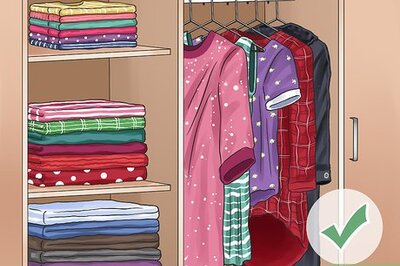


Comments
0 comment